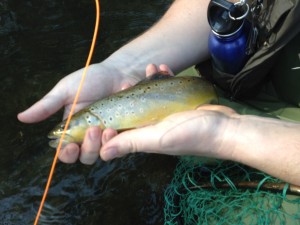Then he opened the fly box to see what he had. Part of the fun of fly fishing for him was trying out different patterns, just to see if he could get bites on them. His stomach tightened up as he began his ritual monologue.
He took a deep breath. Al-right. Tie this bad boy on and see what we can do. He pulled the fly line through his hand until he got to the leader at the end of the line. See what we have here. He held the little stonefly by the hook and pushed the tip of the line through the eyelet on the top. Get this through here. He made a circle around his middle finger, and wound the tip of the line around the rest of the leader a few times, like a noose. Do a little bit of this. He made little staccato cadences with his tongue, pushing out air while tapping it on the back of his teeth. Through here…as he pushed the line tip back through the circle around his middle finger…and…see if we can’t get this. He took the tip of the line upward, through the loop that had been made on top now, forming a kind of circle-eight with the line through both loops. And just for good measure…he licked the line where he had wrapped it around itself, and brought the whole knot into his mouth. Okay, as he pinched the knot and slid it down to the top of the hook, and cinched it against the eyelet. He tested the strength by pulling the fly down hard against the line, and clipped off the excess at the tip. Let’s see what we can do, as he held the fly between his fingers and picked up the rest of the rod to carry it all down to the water.
After walking down the creek a ways and swinging the flies across the water some more, Don checked the time and knew he should work his way back up so the steak wouldn’t burn. When he got back to the base of the path that led up to his table, he decided to cast once more to the spot where he had gotten one on.
Don always tried to make the last cast of the day perfect. With a self- admonishing snort, he wondered why he didn’t do them perfectly every time. He made sure that his arm was fluid and didn’t jerk, and took care to pull the rod far enough back behind him for a good rollout to the target behind the log.
The line unfurled across the water and the leader gently sat the fly on the surface. Don mended the line, lifting the rod and stripping in to get the slack out. A second after he firmed it up, a divot of water popped next to the fly. Don automatically jerked the rod to the air, straight up this time.
The rod instantly bent in half and he was careful to let the extra line slide through his hand quickly, but with enough tension to keep the rod bent. There hadn’t been much excess line stripped out, so it soon got to the point of pulling off the reel.
The drag on the reel was light to allow a quick run, so Don gently dialed it down a couple of notches to make the fish fight against the friction of the cork disc spinning inside the reel.
Don raised the rod high and pointed toward the fish’s run, downstream. Whenever it stopped he swiftly reeled, and the fish bolted away two more times. Finally he could feel that the fish was tired so he walked toward it, steadily winding the line in.
He saw it suspended in the middle, gills pulsing in and out, and he softly tugged the line until the trout was on the shallow silt, next to the bank. It was a beautiful yellow-sided brown, and Don was surprised that he hadn’t jumped at all.
He remembered the description of browns in a story he had read. The Scotsman author had called browns “meditative,” and that had always struck Don. He picked up the fish, and smiled when he found he needed two hands to take its weight. It pushed twenty-two inches and had vivid, fiery red spots through his middle and above the lateral line.
The fish didn’t wriggle out of his grasp, and he knew he wouldn’t eat this trout—wouldn’t even take a picture. The best thing he would take from this fish was how he looked below the clear surface, against the sediment and speckled sand, in his own habitat. Don thought about what the fish’s underwater hold looked like.
A professor of his had once said, “Sin is anything that is not life-giving.” These words struck him now. He remembered how long he had been handling the trout, and rocked him back and forth in the water to breath. He opened his palms and let him glide away. The author might have meant that this fish makes us meditate.
When Don walked up the bank from the stream he could smell the meat and he knew that it was ready. He liked it rare and his deer he took even redder because he knew nothing could taint a clean kill. The factory beef needed to be medium for him to feel good about it.
A small cut in the middle showed pink and it was time to eat and look around. Don chewed the marbled savory. Few things tasted better than those cut with a Buck knife. It was his dad’s old 110 blade, and it connected the meat to the mind in a way that a man can only think of in terms of his father’s days.


